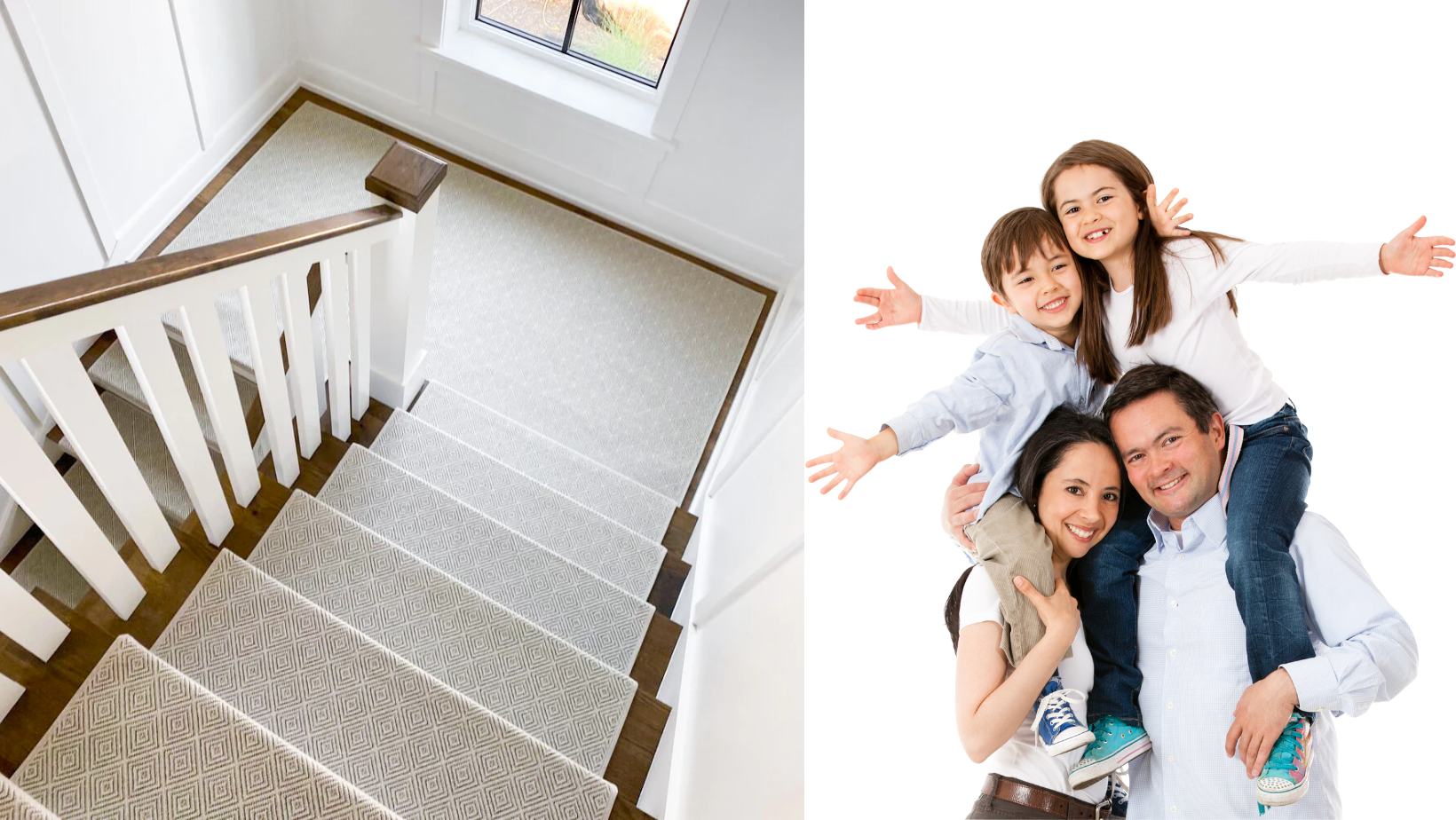Choosing the right staircase materials is crucial for both safety and style.
What is the difference between a stair run and a tread?
A stair tread is the horizontal surface you step on, while a stair run refers to the total horizontal distance a staircase covers.
Understanding this distinction helps homeowners select the best options for durability and aesthetics.
Features like carpet stair treads provide added traction and style while protecting the steps.
This will guide you through the benefits, materials, and installation methods of carpet stair treads, to help you make the best choice for your home.
What Are Stair Treads?
Stair treads are one of the most critical components of a staircase.
They provide a walking surface and contribute to the overall design and safety of the stairs.
Whether made of wood, carpet, metal, or synthetic materials, stair treads must be durable enough to withstand daily foot traffic.
The function of stair treads goes beyond aesthetics.
They offer stability, reduce noise, and can provide traction to prevent slips and falls.
Homeowners can choose stair treads based on their material preferences, durability needs, and interior design goals.
What Can Be Used as Stair Treads?
When selecting stair treads, homeowners have a variety of materials to choose from.
The most common options include:
-
Wood: A classic choice that enhances a staircase’s elegance. Hardwood treads, such as oak, maple, or walnut, provide a timeless look and long-lasting durability.
-
Carpet: Offers comfort and noise reduction, making it ideal for households with children or pets.
-
Laminate: Provides the look of wood at a lower cost while being easy to maintain.
-
Vinyl: Water-resistant and durable, making it a great option for high-traffic areas.
-
Metal: Often used in industrial or modern designs, metal treads are slip-resistant and highly durable.
-
Stone: Marble, granite, or slate treads add a luxurious feel but require professional installation.
Each material has its advantages, so it’s essential to consider factors like slip resistance, maintenance, and overall appearance when choosing stair treads.
Pros and Cons of Stair Treads and Runners
Stair treads and runners each offer unique benefits for safety and style.
Understanding their pros and cons helps homeowners choose the best option.
Benefits of Stair Treads
-
Offer better traction and prevent slipping.
-
Available in various materials and finishes to match home décor.
-
Durable and can last for many years with proper care.
-
Some options, like adhesive-backed treads, are easy to install without professional help.
Drawbacks of Stair Treads
-
Some materials, like wood and stone, can be slippery without additional safety features.
-
Can be noisy compared to carpeted stair runners.
-
Higher-end materials may require professional installation.
Benefits of Stair Runners
-
Add warmth and style to a staircase.
-
Provide a softer surface for walking, reducing foot fatigue.
-
Help minimize noise from foot traffic.
-
Protect the stairs from scratches and wear.
Drawbacks of Stair Runners
-
Require regular cleaning and maintenance.
-
Can be more expensive than individual treads.
-
Installation can be challenging without professional assistance.
Choosing the Right Stair Treads and Runners for Your Home
When selecting stair treads and runners, several factors should be considered:
Safety Considerations
Staircases should comply with safety regulations to prevent accidents.
The International Residential Code (IRC) states that residential stairs must have a minimum tread depth of 11 inches and a maximum riser height of 7 ¾ inches.
These standards ensure safe and comfortable stair navigation.
Adding stair treads with slip-resistant textures or coatings can further enhance safety, especially in homes with children, elderly residents, or pets.
Design and Style
The right stair treads and runners should complement your home’s interior.
Wood tones provide a traditional look, while modern homes may benefit from sleek laminate or metal finishes.
Carpeted treads and runners can add warmth and texture, making a staircase more inviting.
Consider your overall home aesthetic when selecting materials and colors.
Neutral shades offer versatility, while bold patterns can serve as a statement piece.
Durability and Maintenance
Some materials require more maintenance than others. Wood stair treads need regular polishing, while carpeted runners may need frequent vacuuming. Vinyl and laminate options tend to be low-maintenance and easy to clean.
Caring for Stair Treads and Runners
To maintain the appearance and safety of your staircase, follow these care tips:
-
Regular Cleaning: Vacuum stair runners weekly and sweep or wipe down treads to remove dust and dirt.
-
Spot Cleaning: Address spills and stains immediately using a mild detergent and water.
-
Replacing Worn-Out Treads: Over time, stair treads and runners may show signs of wear. Replacing them as needed ensures safety and aesthetic appeal.
Routine maintenance helps extend the life of stair treads and runners, keeping them looking new and functional.
DIY Installation of Carpet Stair Treads and Runners
Installing stair treads and runners can be a manageable project for homeowners comfortable with DIY tasks.
Installing Stair Runners
To install a stair runner, follow these steps:
-
Measure the width and length of the stairs.
-
Cut the runner to fit the staircase dimensions.
-
Secure the runner using nails or a staple gun.
-
Finish the edges with trim or molding for a clean look.
Installing Stair Treads
There are multiple installation methods for stair treads, including:
Tape Installation:
-
Cut the tape to the desired length.
-
Attach it securely to the surface.
-
Press firmly to ensure a secure bond.
Adhesive Installation:
-
Clean the stairs thoroughly before installation.
-
Peel off the backing from the adhesive treads.
-
Press each tread firmly in place, ensuring a tight seal.
For homeowners looking for an easy-to-install solution, Oak Valley Designs offers high-quality stair treads that require minimal tools or expertise.
Are Stair Treads Better Than Stair Runners?
The choice between stair treads and runners depends on personal preference, safety needs, and maintenance considerations.
Stair treads provide direct coverage for each step, offering traction and a sleek look.
Runners, on the other hand, provide a continuous strip of coverage, enhancing comfort and noise reduction.
Homeowners who prefer a low-maintenance option may lean toward stair treads, while those looking for a stylish and cushioned staircase may opt for stair runners.
How Stair Tread Depth and Riser Height Impact Safety
Stair design plays a crucial role in home safety and comfort.
The depth of each tread and the height of each riser determine how easily and safely people can use the stairs.
Why Proper Tread Depth Matters
A deeper stair tread provides more space for each step, reducing the risk of slipping.
According to building codes, the minimum depth for residential stairs is 10 inches, while the International Residential Code (IRC) recommends at least 11 inches for added safety.
Choosing the right tread depth ensures stability and ease of movement, especially for children and elderly individuals.
The Importance of Riser Height
The riser height affects how easily someone can ascend or descend a staircase.
A standard riser should not exceed 7 ¾ inches, as taller risers make stairs harder to climb and increase fall risks.
Proper riser height creates a smooth transition between steps, improving overall stair usability.
Best Maintenance Practices for Stair Treads and Runners
Regular maintenance extends the lifespan of stair treads and runners while keeping them safe for daily use.
Proper care prevents damage, reduces wear, and maintains a clean appearance.
Cleaning Tips for Stair Treads
Wood treads require routine sweeping and occasional polishing to prevent dust buildup.
Carpet stair treads should be vacuumed frequently to remove dirt and allergens.
For synthetic materials like vinyl or laminate, a damp cloth with mild cleaner helps maintain their look without causing damage.
Maintaining Stair Runners for Longevity
Stair runners should be deep cleaned at least twice a year to remove embedded dirt.
Spot cleaning with a gentle detergent prevents stains from setting in, keeping the fabric fresh.
Checking for loose edges or wear ensures the runner remains secure and safe for use.
Steps To Success
Understanding the difference between a stair run and a tread is essential for making informed decisions when upgrading your staircase.
A stair tread is the flat surface where you step, while a stair runner is a decorative and functional strip that partially covers the stairs.
Choosing between the two depends on your preference for safety, durability, and style.
When selecting stair treads, consider materials that offer both traction and aesthetic appeal, such as wood, vinyl, or carpet.
Stair runners provide added comfort and noise reduction but require regular maintenance.
By knowing the key differences, homeowners can create a staircase that enhances both safety and design.
Call Us Today!
Contact Oak Valley Designs today to find the perfect stair treads for your home.
-
Website: https://oakvalleydesigns.com/
-
Phone: 706.331.0315
-
Email: info@oakvalleydesigns.com
-
Address: 30 River Ct SW Bldg E Cartersville, Ga 30120




